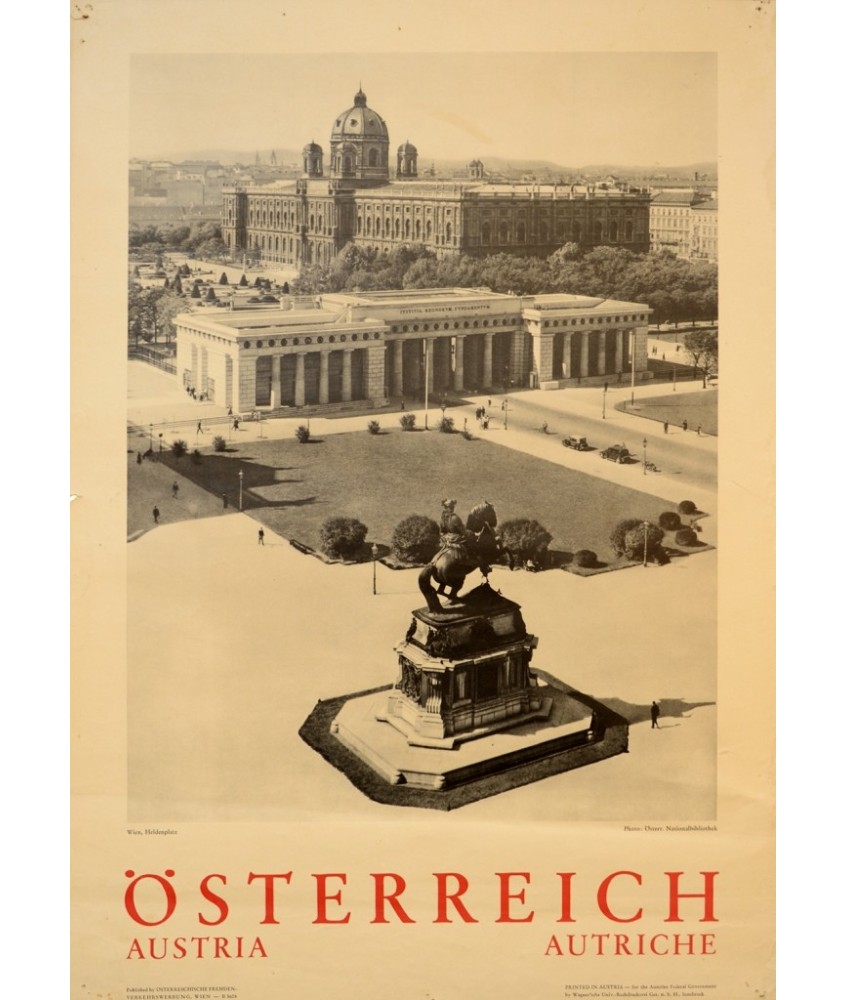


The origins of modern Austria go back to the Habsburg dynasty that made the country a fundamental part of the Holy Roman Empire. In 1867 the Austrian Empire became the Austro-Hungarian Empire. The Habsburg Empire ended in 1918 at the end of the First World War. The First Republic of Austria was established in 1919. In 1938 the country was occupied by Nazi Germany. This occupation would last until the end of World War II
CLASSIFICATION OF THE POSTERS ACCORDING TO THEIR CONSERVATION (in bold the one corresponding to this poster):
A+ Is a flawless example of a poster rarely seen in such fine condition.
A Designates a poster in very fine condition. There may be some tears on the margins, but not noticeable. No paper loss. Colours are fresh and has no blemish.
A- There may be some slight fold marks, tear or other minor defect, but most unobtrusive. Successful restoration if restored.
B+ If some restoration it is not immediately evident.
B Designates a poster in good condition. There may be some tears. Blemish or paper loss, but not in any crucial design area. Colours are fresh and the poster has a very good appearance.
B- Restoration may show some defects. Colours along the fold marks are faded.
C+ Restorations are visible.
C Designates a poster in fair condition. Tears, blemish, fold marks and or paper loss are more pronounced or may slightly affect the image of the poster. Colours may be faded.
C- Requires restoration.
Austria (/ˈɒstriə/ (![]() listen), /ˈɔːs-/;[8] German: Österreich [ˈøːstɐraɪç] (
listen), /ˈɔːs-/;[8] German: Österreich [ˈøːstɐraɪç] (![]() listen)), officially the Republic of Austria (German: Republik Österreich,
listen)), officially the Republic of Austria (German: Republik Österreich, ![]() listen (help·info)), is a landlocked country of over 8.8 million people[4] in Central Europe. It is bordered by the Czech Republic and Germany to the north, Hungary and Slovakia to the east, Slovenia and Italy to the south, and Switzerland and Liechtenstein to the west. The territory of Austria covers 83,879 km2 (32,386 sq mi). The terrain is highly mountainous, lying within the Alps; only 32% of the country is below 500 m (1,640 ft), and its highest point is 3,798 m (12,461 ft).[9] The majority of the population speaks local Bavarian dialects of German as their native language,[10] and German in its standard form is the country's official language.[11] Other local official languages are Hungarian, Burgenland Croatian, and Slovene.[9]
listen (help·info)), is a landlocked country of over 8.8 million people[4] in Central Europe. It is bordered by the Czech Republic and Germany to the north, Hungary and Slovakia to the east, Slovenia and Italy to the south, and Switzerland and Liechtenstein to the west. The territory of Austria covers 83,879 km2 (32,386 sq mi). The terrain is highly mountainous, lying within the Alps; only 32% of the country is below 500 m (1,640 ft), and its highest point is 3,798 m (12,461 ft).[9] The majority of the population speaks local Bavarian dialects of German as their native language,[10] and German in its standard form is the country's official language.[11] Other local official languages are Hungarian, Burgenland Croatian, and Slovene.[9]
Austria is a federal republic with a parliamentary representative democracy comprising nine federated states.[9][12] The capital and largest city, with a population exceeding 1.8 million, is Vienna.[9][13] Other major urban areas of Austria include Graz, Linz, Salzburg and Innsbruck. Austria is consistently ranked as one of the richest countries in the world by per capita GDP terms. The country has developed a high standard of living and in 2018 was ranked 20th in the world for its Human Development Index. The republic declaredits perpetual neutrality in foreign political affairs in 1955. Austria has been a member of the United Nations since 1955,[14] joined the European Union in 1995,[9] and is a founder of the OECD.[15] Austria also signed the Schengen Agreement in 1995,[16] and adopted the euro currency in 1999